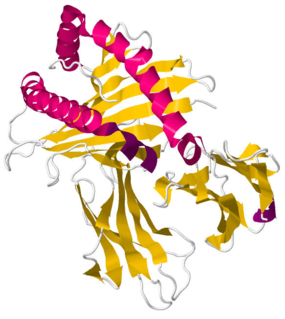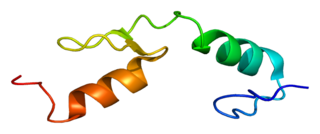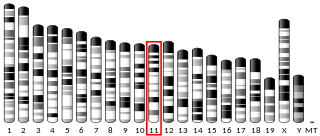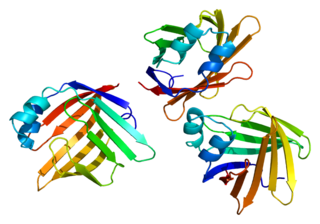
Myelin oligodendrocyte glycoprotein (MOG) is a glycoprotein believed to be important in the myelination of nerves in the central nervous system (CNS). In humans this protein is encoded by the MOG gene. It is speculated to serve as a necessary "adhesion molecule" to provide structural integrity to the myelin sheath and is known to develop late on the oligodendrocyte.

Myelin-associated glycoprotein is a type 1 transmembrane protein glycoprotein localized in periaxonal Schwann cell and oligodendrocyte membranes, where it plays a role in glial-axonal interactions. MAG is a member of the SIGLEC family of proteins and is a functional ligand of the NOGO-66 receptor, NgR. MAG is believed to be involved in myelination during nerve regeneration in the PNS and is vital for the long-term survival of the myelinated axons following myelinogenesis. In the CNS MAG is one of three main myelin-associated inhibitors of axonal regeneration after injury, making it an important protein for future research on neurogenesis in the CNS.

Proteolipid protein 1 (PLP1) is a form of myelin proteolipid protein (PLP). Mutations in PLP1 are associated with Pelizaeus–Merzbacher disease. It is a 4 transmembrane domain protein which is proposed to bind other copies of itself on the extracellular side of the membrane. In a myelin sheath, as the layers of myelin wraps come together, PLP will bind itself and tightly hold the cellular membranes together.

Reticulon 4 receptor (RTN4R) also known as Nogo-66 Receptor (NgR) or Nogo receptor 1 is a protein which in humans is encoded by the RTN4R gene. This gene encodes the receptor for reticulon 4, oligodendrocytemyelin glycoprotein and myelin-associated glycoprotein. This receptor mediates axonal growth inhibition and may play a role in regulating axonal regeneration and plasticity in the adult central nervous system.

Zinc-alpha-2-glycoprotein is a protein that in humans is encoded by the AZGP1 gene.

Large proline-rich protein BAT3 is a protein that in humans is encoded by the BAT3 gene.

Milk fat globule-EGF factor 8 protein (Mfge8), also known as lactadherin, is a protein that in humans is encoded by the MFGE8 gene.

Zinc finger protein 40 is a protein that in humans is encoded by the HIVEP1 gene.

T-cell surface glycoprotein CD1e, membrane-associated is a protein that in humans is encoded by the CD1E gene.

Oligodendrocyte-myelin glycoprotein is a protein that in humans is encoded by the OMG gene.

Protein phosphatase 1 regulatory subunit 11 is an enzyme that in humans is encoded by the PPP1R11 gene.

Myelin P2 protein is a protein that in humans is encoded by the PMP2 gene. Myelin protein P2 is a constituent of peripheral nervous system (PNS) myelin, also present in small amounts in central nervous system (CNS) myelin. As a structural protein, P2 is thought to stabilize the myelin membranes, and may play a role in lipid transport in Schwann cells. Structurally, P2 belongs to the family of cytoplasmic fatty acid-binding proteins (FABPs).

Zinc transporter 4 is a protein that in humans is encoded by the SLC30A4 gene.

Serine/threonine-protein kinase 19 is an enzyme that in humans is encoded by the STK19 gene.

HLA class II histocompatibility antigen, DX beta chain is a protein that in humans is encoded by the HLA-DQB2 gene.

Protein EVI2B is a protein that in humans is encoded by the EVI2B gene.

CD1a is a human protein encoded by the CD1A gene.

Butyrophilin subfamily 2 member A2 is a protein that in humans is encoded by the BTN2A2 gene.

Butyrophilin subfamily 3 member A1 is a protein that in humans is encoded by the BTN3A1 gene.
Butyrophilin is a family of proteins.


















